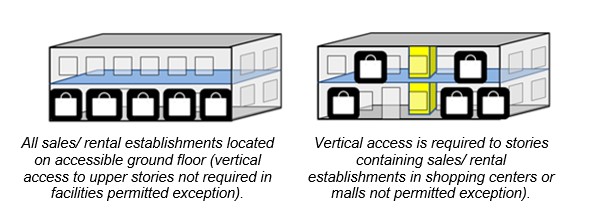Common Questions
If no pedestrian route onto a site is provided, is an accessible route still required?
An accessible route from the boundary of the site is not required where the only means of site arrival is a vehicular way without pedestrian access. Where vehicular ways are also intended to accommodate pedestrian travel, such as a shopping center parking lot, an accessible route is required.
Do accessible routes that cross vehicular ways need to be marked as a crossing?
No, accessible routes that cross vehicular ways are not required by the Standards to be marked as a crossing. The Standards only require access aisles at accessible parking spaces and accessible passenger loading zones to be marked. (Local codes and traffic laws may require crossings to be marked).
Do stories not required to be on an accessible route have to comply with the Standards?
Yes, stories (and mezzanines) not connected by an accessible route must still meet all other applicable requirements in the Standards. This ensures access for people with disabilities who can use stairs and facilitates compliance should vertical access be achieved through later renovations or additions.
Do basements count in determining a facility’s story count?
As defined in the Standards, a “story” pertains to those portions of buildings “designed for human occupancy included between the upper surface of a floor and upper surface of the floor or roof next above” (§106.5). A basement or other level below grade designed for human occupancy (i.e., equipped with lighting, ventilation, and means of egress) counts as a story. Basements or other levels not containing any space designed for human occupancy are not considered stories under the Standards.
Is an accessible route required to rooftop levels?
In facilities where an accessible route is required to each story (§206.2.3), an accessible route must serve rooftop levels that contain public or common use spaces or elements that are required to be accessible, such as sun decks, lounges, dining areas, bars, or swimming pools. An accessible route is not required to rooftop levels in those facilities that are exempt from the requirement for an accessible route to each story based on the number of stories or the square footage per story. In determining whether a facility qualifies for this exception, rooftop levels are not counted as a story unless they meet the definition of “story.” The Standards define a story as “that portion of a building or facility designed for human occupancy,” (i.e., equipped with lighting, ventilation, and means of egress) that is “included between the upper surface of a floor and upper surface of the floor or roof next above” (§106.5).
Do the exceptions for accessible routes between stories apply to facilities that are only partially occupied by entities not permitted the exception, such as health care facility or shopping center?
Accessible routes between stories are not required in private sector facilities that are either less than 3 stories or that have less than 3,000 square feet per story excluding the professional offices of health care providers, shopping centers and malls with at least 5 sales or rental establishments, and public transit facilities, including airport terminals. In mixed use facilities that otherwise qualify for this exception, an accessible route is required to serve each story containing occupancies not permitted the exception. For example, if all sales or rental establishments of a shopping center are on the same story, an accessible route is required only to that story. If located on multiple stories, an accessible route must connect to each story that contains a sales or rental establishment.
When alterations are made on an upper story of a facility, is vertical access required?
If an alteration includes installation of a stair or escalator where none existed previously and involves major structural modifications, an accessible route between levels served by the stair or escalator is required (unless an accessible route already exists). If alterations are made to a primary function area on an upper floor, an accessible path of travel to the area is required to the extent that the cost is not disproportionate (i.e., more than 20% of the cost of the overall alteration). In any alteration, an accessible route between stories is not required in a facility that qualifies for those exceptions permitted in new construction based on the number of stories or square footage per floor.
When an addition increases the number of stories or square footage beyond the maximum permitted by the exception, is an accessible route between stories required?
If a facility no longer qualifies for the exception for multi-story facilities due to an increase in square footage or stories, an accessible route between stories is required where the work also includes installation of a stair or escalator where none existed previously and major structural modifications are needed (unless a compliant accessible route between stories already exists). The accessible route must connect the levels served by the new stair or escalator. Also, if the addition includes a primary function area, an accessible path of travel to the primary function area is required, including where it involves travel between stories or levels, to the extent the cost does not exceed 20% of the cost of the overall alteration. Compliance in an alteration, including with the requirement for an accessible route between stories, is not required where it is “technically infeasible.” In this case, compliance is required to the maximum extent feasible.



User Comments/Questions
Add Comment/Question